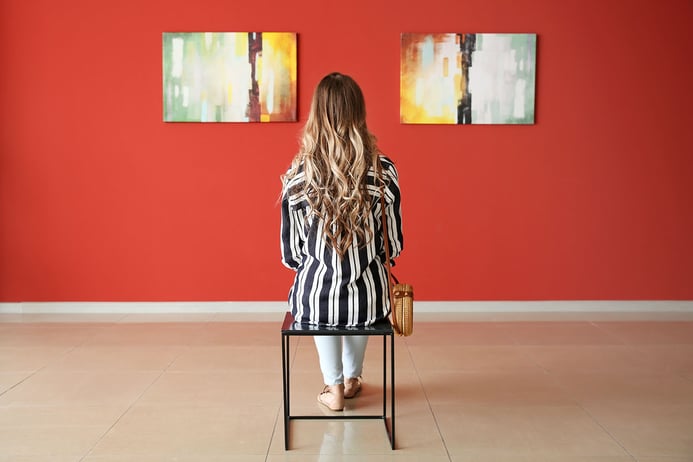A look into the role of art in hospitality spaces and its beneficial impact on customers, employees and company identity.
The benefits of art
Whether we are looking at the enormous industry built around interior design or start-ups helping companies create a hospitable environment for clients and employees alike, the aesthetic context matters. The importance of physical environments, particularly in service-bound industries, is amply documented by research (Bitner, 1992; Harris & Ezeh, 2008; Rosenbaum & Massiah, 2011; Suh, Moon, Han, & Ham, 2014; Wakefield & Blodgett, 1996; Zemke & Pullman, 2008). Interestingly, all of the aforementioned articles point to the strong effect that the environment (often referred to as ‘servicescapes’) has on customers’ and employees’ emotional as well as cognitive responses. More specifically, studies show the effect on customer satisfaction (Bitner, 1992), customer loyalty (Harris & Ezeh, 2008; Suh et al., 2014) and even financial performance (Zemke & Pullmann, 2008).
Well-being
Exposing art in a physical space is more than just creating an appealing aesthetic environment. Several studies provide evidence that art has a beneficial impact on our spirit and health (Stuckey, H.L., & Nobel, J.M. ,2010; Jensen, Anita & Bonde, Lars Ole, 2018). For instance, engaging with art has been shown to contribute in reducing stress and depression, just to name two of the various positive psychological impacts (Stuckey, H.L., & Nobel, J.M. ,2010). A study from the University of Westminster shows that simple lunchtime visits to an art gallery can cause rapid normalization of cortisol levels from the consequences of high stress on office workers. Furthermore, the act of interpreting art is an important intellectual stimulation. To that end, a study by Knight and Haslam (2010), demonstrates that workers in an office enriched by art can increase employee productivity up to 15%, and up to 37%, if employees get actively involved in the selection process of the art pieces to be exhibited.
Branding and identity
Art can be a way of expressing a company’s identity. There are many forms through which organizations may choose to showcase their identity: through declared values and beliefs, training and development, or contrasting as to how a company is different to its competition. Prior research shows that art and the choice of interior design can also reflect the identity of the organization and its overall purpose (Foroudia, Balmer, Chen, Foroudi, & Patsala, 2020). More specifically, the atmosphere created can impact one’s organizational identity by making implicit indication on the norms and expectations within a servicescape. To that end, the physical expression is a means of communication and representation that can be used for storytelling towards employees, but also stakeholders at large. Last but not least, while the identity is important as it encapsulates what employees think and believe about their organization, it also translates into an image that external stakeholders hold about the organization, for instance customer beliefs (Bitner, 1992; Nguyen and Leblanc, 2002).
Culture and context
Finally, art is a way to connect with the larger environment. When well-executed, hospitality and art should work hand in hand, both offering an experience and a sense of escape. Art can be understood, transmitted and exchanged in any context. From well-known icons, to still lifes of Switzerland, or contemporary urban culture, each city has a wide variety of possibilities for showcasing its region through art made by local artists. In hospitality, local art brings a cultural touch of warmth, community and solidarity that allows customers to interact and connect with the local environment. This is the motivation behind the start-up, Artysco, whose aim is to hook up local artists with creatively-conscious companies, establishing a link so that hotels, businesses and professional service firms can rent pieces from local artists.
Bringing hospitality elements together
In the hotel industry specifically, many concept hotels have managed to bring together locals and tourists, creating a welcoming environment and a place for community gathering. Through the servicescape, architecture design, food and art there are many ways of creating a unique experience. Renting from local artists is not only a way of connecting with the community, but also an innovative way of transmitting what a travel destination stands for to its tourists. Art brings the local and historical culture to life, and the traveler is then imbued, inspired and transported. Travelers are now looking for unique and authentic experience when discovering a new place. Showcasing local artwork can give the possibility to travelers to immerse themselves in local cultures right in the hotel premises.
Art is a fairly unvetted part of how hospitality is created. While it is an established constituent of the interior design discussion, there is little consideration as to how art creates hospitable environments and why it matters not only for hotels in particular, but service companies at large. Certainly, research has provided ample evidence that art has numerous positive effects – aside from creating a pleasant environment – yet little light has been cast on how it creates and enhances hospitality. This is an area that would merit further research, because in the end, creating a truly hospitable experience is truly an art in itself!
References
Bitner, M. J. (1992). Servicescapes: The Impact of Physical Surroundings on Customers and Employees. Journal of Marketing,56(2), 57. doi:10.2307/1252042
Clow, Angela. (2006). Normalisation of salivary cortisol levels and self-report stress by a brief lunchtime visit to an art gallery by London City workers. Journal of Holistic Healthcare. 3.
Foroudi, M. M., Balmer, J. M., Chen, W., Foroudi, P., & Patsala, P. (2020). Explicating place identity attitudes, place architecture attitudes, and identification triad theory. Journal of Business Research, 109, 321-336.
Harris, L. C., & Ezeh, C. (2008). Servicescape and loyalty intentions: An empirical investigation. European Journal of Marketing,42(3/4), 390-422. doi:10.1108/03090560810852995
Jensen, Anita & Bonde, Lars Ole. (2018). The use of arts interventions for mental health and wellbeing in health settings. Perspectives in Public Health. 138. 175791391877260. 10.1177/1757913918772602.
Knight, C., & Haslam, S. A. (2010). The relative merits of lean, enriched, and empowered offices: An experimental examination of the impact of workspace management strategies on well-being and productivity. Journal of Experimental Psychology: Applied, 16(2), 158-172. https://doi.org/10.1037/a0019292
Nguyen, Nha & Leblanc, Gaston. (2002). Contact personnel, physical environment and the perceived corporate image of intangible services by new clients. International Journal of Service Industry Management. 13. 242-262. 10.1108/09564230210431965.
Rosenbaum, M. S., & Massiah, C. (2011). An expanded servicescape perspective. Journal of Service Management,22(4), 471-490. doi:10.1108/09564231111155088
Stuckey, H.L., & Nobel, J.M. (2010). The connection between art, healing, and public health: a review of current literature. American journal of public health, 100 2, 254-63.
Suh, M., Moon, H., Han, H., & Ham, S. (2014). Invisible and Intangible, but Undeniable: Role of Ambient Conditions in Building Hotel Guests’ Loyalty. Journal of Hospitality Marketing & Management,24(7), 727-753. doi:10.1080/19368623.2014.945223
Wakefield, K. L., & Blodgett, J. G. (1996). The effect of the servicescape on customers’ behavioral intentions in leisure service settings. Journal of Services Marketing,10(6), 45-61. doi:10.1108/08876049610148594
Zemke, D. M., & Pullman, M. (2008). Assessing the value of good design in hotels. Building Research & Information,36(6), 543-556. doi:10.1080/09613210802380993





